Themed collection The central role of the d-block metals in the periodic table

The central role of the d-block metals in the periodic table
Welcome to this themed issue of Dalton Transactions entitled “The central role of the d-block metals in the periodic table”

Dalton Trans., 2019,48, 9405-9407
https://doi.org/10.1039/C9DT90117E
Superparamagnetic iron oxide nanoparticulate system: synthesis, targeting, drug delivery and therapy in cancer
Usefulness of Superparamagnetic Iron oxide Nanoparticulate system for biomedical applications through targeting, drug delivery and therapy.
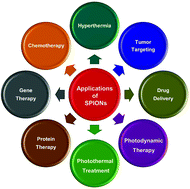
Dalton Trans., 2019,48, 9490-9515
https://doi.org/10.1039/C9DT00459A
Perovskites with d-block metals for solar energy applications
In this review, we present the most characteristic photoactive perovskites that can be formed with the help of d-block metals.
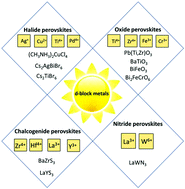
Dalton Trans., 2019,48, 9516-9537
https://doi.org/10.1039/C9DT01485C
Structure and reactivity of the first-row d-block metal-superoxo complexes
This review discusses the structure and reactivity of metal-superoxo complexes covering all ten first-row d-block metals from Sc to Zn.
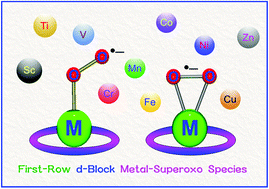
Dalton Trans., 2019,48, 9469-9489
https://doi.org/10.1039/C9DT01402K
A look at periodic trends in d-block molecular electrocatalysts for CO2 reduction
Periodic trends in the electronic structure of the transition metal centers can be used to explain the observed CO2 reduction activities in molecular electrocatalysts for CO2 reductions. Research activities concerning both horizontal and vertical trends have been summarized with mononuclear complexes from Group 6 to Group 10.
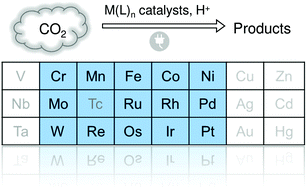
Dalton Trans., 2019,48, 9454-9468
https://doi.org/10.1039/C9DT00491B
Fe in biosynthesis, translocation, and signal transduction of NO: toward bioinorganic engineering of dinitrosyl iron complexes into NO-delivery scaffolds for tissue engineering
The ubiquitous physiology of nitric oxide enables the bioinorganic engineering of [Fe(NO)2]-containing and NO-delivery scaffolds for tissue engineering.
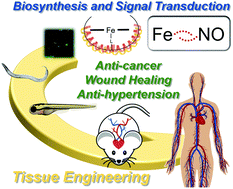
Dalton Trans., 2019,48, 9431-9453
https://doi.org/10.1039/C9DT00777F
Evolution and understanding of the d-block elements in the periodic table
The d-block elements have played a critical role in the development of the modern periodic table.
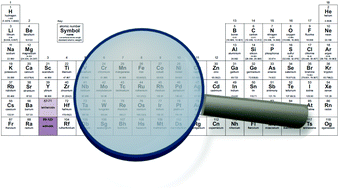
Dalton Trans., 2019,48, 9408-9421
https://doi.org/10.1039/C9DT00765B
The past, present, and future in the nomenclature and structure representation of inorganic compounds
Where we have been and where we are going in precisely describing structures of inorganic compounds.
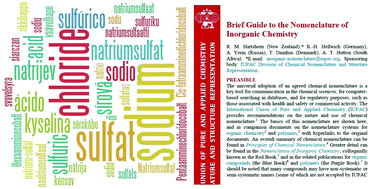
Dalton Trans., 2019,48, 9422-9430
https://doi.org/10.1039/C9DT00352E
The Chatt reaction: conventional routes to homoleptic arenemetalates of d-block elements
Homoleptic arenemetalates, including the depicted [K(18-crown-6)]2[Hf(C14H10)3], are often useful sources of “naked” metal anions and have been obtained for several transition metals via the Chatt reaction, named in honor of Joseph Chatt, a giant of chemistry.
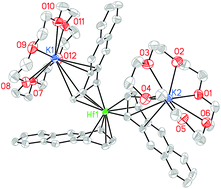
Dalton Trans., 2019,48, 9538-9563
https://doi.org/10.1039/C8DT05029E
Cobalt-based molecular electrocatalysis of nitrile reduction: evolving sustainability beyond hydrogen
Two complexes, designed as hydrogen evolution catalysts, are shown to be the first earth-abundant molecular electrocatalysts for reduction of acetonitrile to ethylamine.
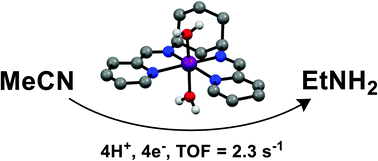
Dalton Trans., 2019,48, 9576-9580
https://doi.org/10.1039/C9DT00773C
Isolation of chloride- and hydride-bridged tri-iron and -zinc clusters in a tris(β-oxo-δ-diimine) cyclophane ligand
Chloride- and hydride-bridged tri-iron and -zinc clusters decorated with amine protons were successfully isolated in a cage-type ligand.
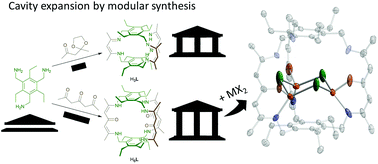
Dalton Trans., 2019,48, 9570-9575
https://doi.org/10.1039/C9DT00799G
Generation of maghemite nanocrystals from iron–sulfur centres
Electron beam induced generation of maghemite nanocrystals from polymer-encapsulated iron–sulfur centres.
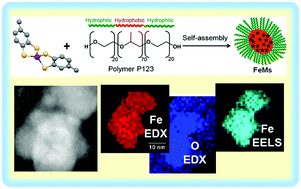
Dalton Trans., 2019,48, 9564-9569
https://doi.org/10.1039/C9DT00514E
Photorelease of a metal-binding pharmacophore from a Ru(II) polypyridine complex
As a potential prodrug concept, a metal-binding metalloenzyme inhibitor fragment can be released via light from a Ru(II) polypyridine complex.
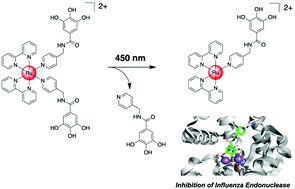
Dalton Trans., 2021,50, 2757-2765
https://doi.org/10.1039/D0DT04290K
A portable oligonucleotide-based microfluidic device for the detection of VEGF165 in a three-step suspended-droplet mode
We successfully applied a G-quadruplex-based VEGF165 aptasensing platform to a suspended droplet-based portable microfluidic device using a polypropylene-based chip.
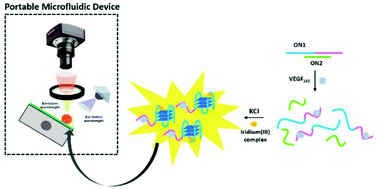
Dalton Trans., 2019,48, 9824-9830
https://doi.org/10.1039/C9DT00427K
Improving the efficiency of copper-dye-sensitized solar cells by manipulating the electrolyte solution
The crucial role of tert-butylpyridine and lithium bis(trifluoromethanesulfonyl)imide in the performance of sustainable “full-copper” DSSCs.
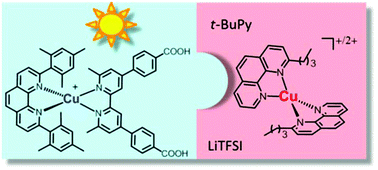
Dalton Trans., 2019,48, 9818-9823
https://doi.org/10.1039/C9DT01448A
Mono, bis, and tris(phosphoramidate) titanium complexes: synthesis, structure, and reactivity investigations
A series of variously substituted phosphoramidate titanium complexes bearing dimethylamido ligands are reported.

Dalton Trans., 2019,48, 9782-9790
https://doi.org/10.1039/C9DT00911F
Palladium pincer complexes featuring an unsymmetrical SCN indene-based ligand with a hemilabile pyridine sidearm
Combining thiophosphinoyle and methylpyridine sidearms to endow hemilabile character to indenediide palladium pincer complexes.
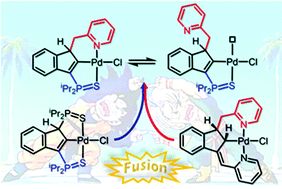
Dalton Trans., 2019,48, 9801-9806
https://doi.org/10.1039/C9DT00898E
Influence of geometric isomerism on the binding of platinum anticancer agents with phospholipids
A holistic approach to the molecular mechanism of platinum anti-cancer agents extends DNA interactions to membrane phospholipids relevant to cellular accumulation and delivery.
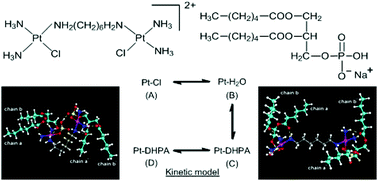
Dalton Trans., 2019,48, 9791-9800
https://doi.org/10.1039/C9DT00753A
A highly conductive nanostructured PEDOT polymer confined into the mesoporous MIL-100(Fe)
A novel nanostructured conducting polymer@MOF composite has demonstrated an enhanced conductivity and a reversible and cyclable electrochromic switching.
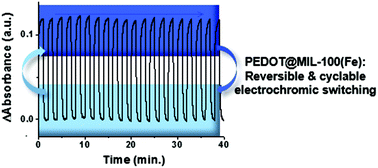
Dalton Trans., 2019,48, 9807-9817
https://doi.org/10.1039/C9DT00917E
A d10 Ag(I) amine–borane σ-complex and comparison with a d8 Rh(I) analogue: structures on the η1 to η2:η2 continuum
The bonding in H3B·NMe3 σ-complexes of d8-Rh(I) and d10-Ag(I) show subtle differences, as probed by structural, spectroscopic and computational studies.
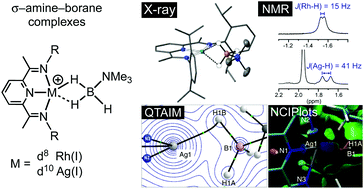
Dalton Trans., 2019,48, 9776-9781
https://doi.org/10.1039/C9DT00971J
Photoluminescent Cu(I) vs. Ag(I) complexes: slowing down emission in Cu(I) complexes by pentacoordinate low-lying excited states
Replacement of copper(I) ions by silver(I) improves the solid-state photoluminescence properties.
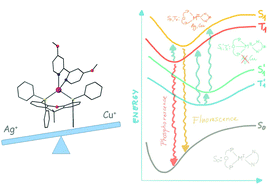
Dalton Trans., 2019,48, 9765-9775
https://doi.org/10.1039/C9DT00772E
Ring size effects in cyclic fluorophosphites: ligands that span the bonding space between phosphites and PF3
From the evidence of the Mo(0), Pt(0) and Rh(I) complexes of cyclic fluorophosphites containing 5- to 8-membered rings, the binding properties depend critically on the ring size.
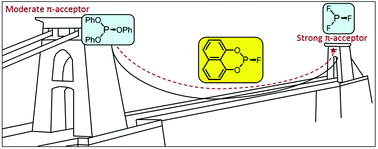
Dalton Trans., 2019,48, 9712-9724
https://doi.org/10.1039/C9DT00893D
Bipyridine-based iridium(III) triplet emitters for organic light-emitting diodes (OLEDs): application and impact of phenyl substitution at the 5′-position of the N-coordinating pyridine ring
Three blue phosphorescent homoleptic iridium(III) complexes based on a bipyridine ligand were synthesized.
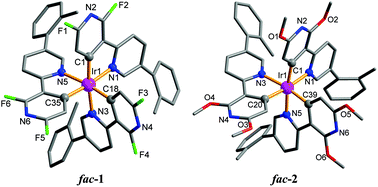
Dalton Trans., 2019,48, 9734-9743
https://doi.org/10.1039/C9DT00596J
Coordination design of cadmium ions at the 4-fold axis channel of the apo-ferritin cage
Construction and X-ray structure analysis of Cd(II) binding sites at the 4-fold symmetric hydrophobic channel of apo-ferritin by introduction of Cys residues.
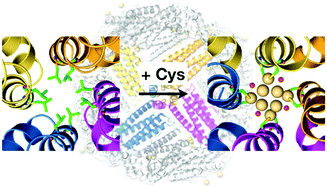
Dalton Trans., 2019,48, 9759-9764
https://doi.org/10.1039/C9DT00609E
Evaluation of dicopper azacryptand complexes in aqueous CuAAC reactions and their tolerance toward biological thiols
The catalytic activity of dicopper azacryptands was evaluated in water and in the presence of biological thiols.
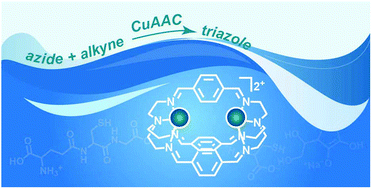
Dalton Trans., 2019,48, 9751-9758
https://doi.org/10.1039/C9DT00724E
Efficient sky-blue OLEDs with extremely low efficiency roll-off based on stable iridium complexes with a bis(diphenylphorothioyl)amide ligand
Two sky-blue Ir(III) complexes, with peaks at 466 and 474 nm, were applied to OLEDs, with a maximum EQE of 19.4% and extremely low efficiency roll-off.
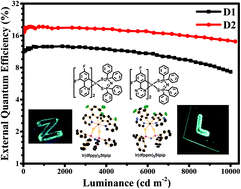
Dalton Trans., 2019,48, 9744-9750
https://doi.org/10.1039/C9DT00298G
Azole-containing cationic bis-cyclometallated iridium(III) isocyanide complexes: a theoretical insight into the emission energy and emission efficiency
Blue-emission of Ir(III) isocyanide complexes was quenched by a metal-centred d–d* triplet state.

Dalton Trans., 2019,48, 9725-9733
https://doi.org/10.1039/C9DT00412B
Towards efficient sustainable full-copper dye-sensitized solar cells
Two new heteroleptic copper(I) sensitizers with π-delocalized ancillary ligands for full copper DSSCs.
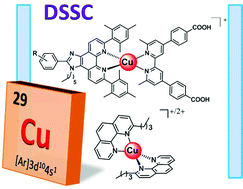
Dalton Trans., 2019,48, 9703-9711
https://doi.org/10.1039/C9DT00790C
Iridium(III) polypyridine complexes with a disulfide linker as biological sensors and cytotoxic agents
The synthesis, characterization, and photophysical properties of novel iridium(III) polypyridine complexes as thiol-sensing probes and cytotoxic agents are reported.
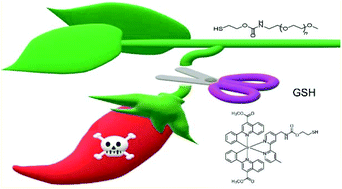
Dalton Trans., 2019,48, 9692-9702
https://doi.org/10.1039/C9DT00793H
Luminescent properties of a 3,5-diphenylpyrazole bridged Pt(II) dimer
We report the synthesis, electrochemistry, photophysics and electroluminescence of a highly luminescent pyrazolate-bridged platinum(II) complex. Light-emitting electrochemical cells (LEECs) of this dimer complex were among the brightest and most efficient LEECs from dinuclear compounds to date.
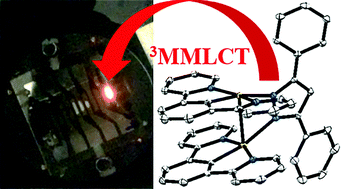
Dalton Trans., 2019,48, 9684-9691
https://doi.org/10.1039/C9DT00795D
Sublimable cationic iridium(III) complexes with large steric hindrance for high-performance organic light-emitting diodes
Highly efficient sublimable cationic iridium(III) complexes with bulky ancillary and major ligands.
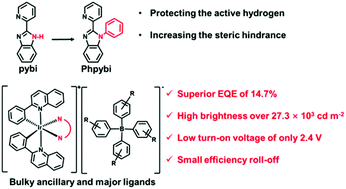
Dalton Trans., 2019,48, 9669-9675
https://doi.org/10.1039/C9DT00495E
Cyclometallation reactions of a three-coordinate cobalt(I) complex bearing a nonsymmetric N-heterocyclic carbene ligand
The reactions of a three-coordinate cobalt(I)–N-heterocyclic carbene complex with different organometallic reagents afford different cyclometallated cobalt–N-heterocyclic carbene complexes.
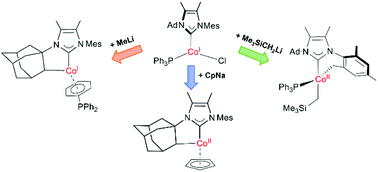
Dalton Trans., 2019,48, 9676-9683
https://doi.org/10.1039/C9DT00731H
Copper potentiates azole antifungal activity in a way that does not involve complex formation
Modulating copper levels in the growth environment influences tolerance of Candida albicans to azole antifungal drugs.

Dalton Trans., 2019,48, 9654-9662
https://doi.org/10.1039/C9DT00642G
Oxidation reactions of a nucleophilic palladium carbene: mono and bi-radical carbenes
A series of mono and bi-radical carbenes.
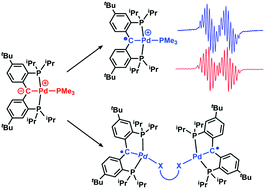
Dalton Trans., 2019,48, 9663-9668
https://doi.org/10.1039/C9DT00585D
Conjugated, rigidified bibenzimidazole ancillary ligands for enhanced photoluminescence quantum yields of orange/red-emitting iridium(III) complexes
A family of six orange/red-emitting cationic iridium complexes were synthesized and their optoelectronic properties comprehensively characterized.
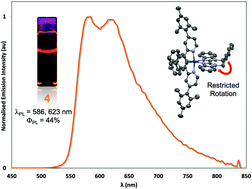
Dalton Trans., 2019,48, 9639-9653
https://doi.org/10.1039/C9DT00423H
Wrinkled two-dimensional ultrathin Cu(II)-porphyrin framework nanosheets hybridized with polypyrrole for flexible all-solid-state supercapacitors
A flexible Cu-TCPP/PPy electrode was fabricated through a direct oxidation polymerization of PPy on a wrinkled 2D Cu-TCPP film.

Dalton Trans., 2019,48, 9631-9638
https://doi.org/10.1039/C8DT05069D
Rhodium(I) complexes with carborane-substituted P,N ligands: investigations of electronic structure and dynamic behaviour
Two distorted square-planar RhI complexes (1 and 2) were obtained from [{RhCl(η4-cod)}2] and the respective P,N ligands.
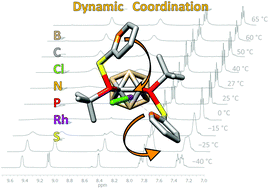
Dalton Trans., 2019,48, 9625-9630
https://doi.org/10.1039/C9DT00628A
First-row early transition metal complexes with a highly sterically demanding triisopropylphenyl amino triphenolate ligand: synthesis and applications
A highly sterically demanding amino triphenolate ligand was successfully synthesized, and early transition metal complexes (Ti, V, Cr, and Mn) supported by the ligand were also obtained and fully characterized.
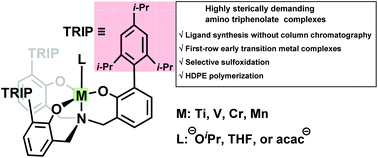
Dalton Trans., 2019,48, 9617-9624
https://doi.org/10.1039/C9DT00456D
Catalytic intramolecular hydroamination of aminoallenes using titanium complexes of chiral, tridentate, dianionic imine-diol ligands
Earth abundant and non-toxic titanium catalysts supported by readily prepared chiral ligands catalyze hydroamination of aminoallenes that lack-protecting groups.
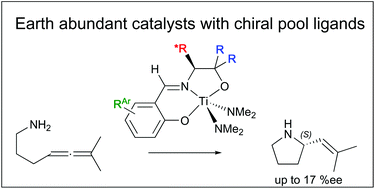
Dalton Trans., 2019,48, 9603-9616
https://doi.org/10.1039/C8DT05156A
A molecular noble metal-free system for efficient visible light-driven reduction of CO2 to CO
A new iron complex bearing a pentadentate quinoline–pyridine ligand exhibits excellent photocatalytic activity towards CO2-to-CO conversion using the commercially available organic dye purpurin as the photosensitizer and BIH as the electron donor.
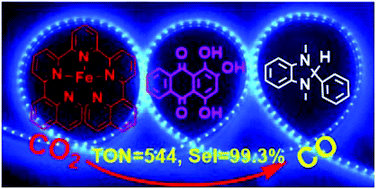
Dalton Trans., 2019,48, 9596-9602
https://doi.org/10.1039/C9DT00425D
Unveiling reactive metal sites in a Pd pincer MOF: insights into Lewis acid and pore selective catalysis
NOBF4 enables efficient oxidative ligand exchange in a Pd pincer MOF, generating a highly active and recyclable Lewis acid catalyst.
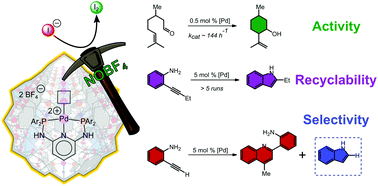
Dalton Trans., 2019,48, 9588-9595
https://doi.org/10.1039/C8DT03801E
A comparative analysis of hydrosilative amide reduction catalyzed by first-row transition metal (Mn, Fe, Co, and Ni) N-phosphinoamidinate complexes
Screening reveals (PN)Ni(X) pre-catalysts to be effective for the hydrosilative reduction of amides under mild conditions.
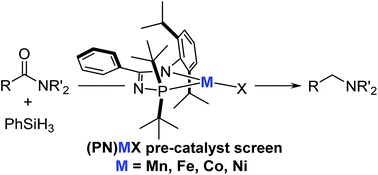
Dalton Trans., 2019,48, 9581-9587
https://doi.org/10.1039/C8DT04221G
Anti-Markovnikov terminal and gem-olefin hydrosilylation using a κ4-diimine nickel catalyst: selectivity for alkene hydrosilylation over ether C–O bond cleavage
The hydrosilylation of terminal alkenes, allyl ethers, and gem-olefins has been demonstrated using (Ph2PPrDI)Ni between 25 and 70 °C.

Dalton Trans., 2019,48, 461-467
https://doi.org/10.1039/C8DT04608E
Phosphane tuning in heteroleptic [Cu(N^N)(P^P)]+ complexes for light-emitting electrochemical cells
The effects on photo-and electroluminescent properties of structurally modifying the bisphosphane in [Cu(N^N)(P^P)]+ complexes (N^N = bpy, 6-Mebpy, 6,6′-Me2bpy) are described.
![Graphical abstract: Phosphane tuning in heteroleptic [Cu(N^N)(P^P)]+ complexes for light-emitting electrochemical cells](/en/Image/Get?imageInfo.ImageType=GA&imageInfo.ImageIdentifier.ManuscriptID=C8DT03827A&imageInfo.ImageIdentifier.Year=2019)
Dalton Trans., 2019,48, 446-460
https://doi.org/10.1039/C8DT03827A
Correction: Iridium(III) polypyridine complexes with a disulfide linker as biological sensors and cytotoxic agents
Dalton Trans., 2019,48, 9831-9831
https://doi.org/10.1039/C9DT90095K
About this collection
This special issue of Dalton Transactions focuses on the inorganic chemistry of the transition metals, in celebration of the International Year of the Periodic Table. Guest edited by Catherine Housecroft (University of Basel), Christine Thomas (The Ohio State University), and Mi Hee Lim (Korea Advanced Institute of Science and Technology (KAIST)), this collection of reports and perspectives highlights the important role that d-block metals play in sustainable energy, catalysis, diagnostics and medicine, and chemical education.